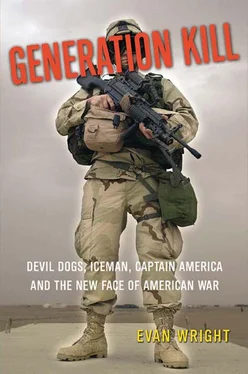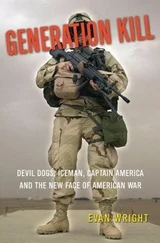“Uh, oh. Here he comes,” Colbert says, glimpsing the chaplain traipsing across the sand with a smile, a Bible and a Marine bodyguard toting an assault rifle. “Another nuisance to waste my time.”
Manimal walks over, shooting the chaplain suspicious glances. “Back at Mathilda I went to a service to get communion, but the priest gave a fucking moto speech on why we are fighting this war. It was fucking bullshit.”
Fifty meters from Colbert’s vehicle, the chaplain gathers a small crowd of faithful in the sand. A huge, lumbering, bald Marine gunnery sergeant removes his helmet, kneels and reads Psalm 91. Then the chaplain delivers a sermon. Marines call themselves “Devil Dogs”—according to lore, German soldiers in World War I nicknamed them this, “Tuffen Hunds,” in grudging praise of their tenacity—and the chaplain incorporates this into his sermons. “They nickname you Devil Dogs,” he tells his flock. “But Jesus was the original Devil Dog. He faced evil, and he beat it. Jesus is the Devil Dog you will want on your side going into battle.”
By Colbert’s Humvee, a twenty-year-old redheaded corporal jumps up as more helicopters fly north. “Get some!” he screams. Then he adds, “They kill hundreds of people, those pilots. I would have loved to have flown the plane that dropped the bomb on Japan. A couple dudes killed hundreds of thousands. That fucking rules! Yeah!”
°
AT SEVEN O’CLOCK on the night of March 20, the Marines in First Recon are ordered into their vehicles, to load their rifles and drop belts of ammo into the feed trays of their machine guns and to prepare to move out. At this time, more than 25,000 Marines, 20,000 British troops and 30,000 U.S. Army soldiers in the northern Kuwait desert are all doing the same. The 242-kilometer-long Iraqi border with Kuwait is fortified with fences, minefields and seven-meter-high earthen berms. On the other side there are some 50,000 Iraqi troops equipped with more than 1,000 tanks and other types of armor.
The booming we’ve heard since the morning has been the American bombardment of Iraqi positions near the border. According to officers I’ve spoken to, Marine intelligence personnel hacked into the computer of the Iraqi general in command of forces there, and Maj. Gen. Mattis has been personally e-mailing him, urging him to surrender. But the Iraqis have not. They have spent the day firing artillery intermittently and ineffectively toward American units in the desert. Earlier in the morning, Iraqi soldiers were observed out in the open by the border, laying more mines.
In a couple of hours, Marine and Army engineers in armored units are going to race up to the border, supported by heavy American artillery, rocket and aerial bombardment, and blow breaches through the berms. The U.S. Army’s Third Infantry Division will push north to a broad superhighway that goes for nearly 600 kilometers all the way to Baghdad, then travel on it largely unopposed until coming to within about 150 kilometers of the capital.
The Marines and British forces will be in a race the moment they blast through the berms. Their objectives are to reach and secure the oil facilities and ports around Rumaylah, Basra and Um Qasr some seventy kilometers to the east of the border crossing. The American fear is that the Iraqis will begin blowing up these oil and port facilities, causing an environmental disaster. Coalition forces hope to secure them within the first forty-eight hours of the invasion.
First Recon will enter the breach at the border following mechanized Marine elements. But while they cut to the east toward Basra, First Recon will race ninety kilometers north, on its own, to secure a bridge over the Euphrates. The biggest concern for First Recon after crossing the border is that the battalion will be operating solo. Unlike the Army and other Marine units that include thousands of troops, armored vehicles and heavy artillery guns all moving together, First Recon’s 374 Marines in Humvees and trucks will move alone on a trek through open desert believed to contain tens of thousands of Iraqi soldiers. While most enemy forces are expected to scatter, even a few rogue Iraqi tanks with crews willing to fight could wreak havoc on First Recon.
The point of Mattis’s plan to send First Recon ahead of his main battle forces is that this battalion will be among the fastest on the battlefield. As beat-up as First Recon’s Humvees are, they are quicker than tanks and, due to their small numbers, they can outmaneuver large concentrations of enemy forces. According to the doctrine of maneuver warfare, their relative speed, not their meager firepower, is their primary weapon. True to his radio call sign, “Chaos,” Mattis will use First Recon as his main agent for causing disorder on the battlefield by sending the Recon Marines into places where no one is expecting them. At this time in the invasion, none of the enlisted men in First Recon fully understand that this is the plan. They think they are embarking on a fairly conventional recon mission to seize a remote bridge on the Euphrates. Many believe they will have no role in the invasion following this mission.
AT ABOUT EIGHT-THIRTY on the night of the twentieth, engineers in Marine Regimental Combat Team Five (one of the three regimental forces, each composed of about 6,000 troops, that belong to the First Division) begin blasting breach holes through the berms at the Iraqi border. An hour later, at First Recon’s staging area twenty kilometers south, the Marines are told to start their engines.
The four Marines in Colbert’s vehicle have already been sitting inside in total darkness, waiting for a few hours, when they receive the order.
“So we’re going to go invade a country,” Person says cheerily as he hits the ignition.
“I bet gas prices will be lower,” says Trombley, who sits to my left in the backseat.
Adding to the natural stimulation everyone feels at starting an invasion, quite a few Marines have begun eating Nescafé instant coffee crystals straight from foil packets and popping ephedra and other over-the-counter go pills for what is expected to be an all-night mission. Everyone’s already tired. They’ve been up since four or five in the morning, when the explosions started in the desert, and they spent the day diving in and out of holes during all the gas-attack and Scud alerts.
Unlike the Humvees used by elite Army units, which have armor and air-conditioning, most of First Recon’s Humvees don’t even have doors or roofs. Some teams modified them by welding in extra racks for ammo and removing windshields so they can fire their rifles through them. The Humvees are so stuffed full of weapons and supplies, the men hang their rucksacks filled with personal gear on the sides of the vehicles. One Marine observes that the Humvees look like the truck driven by the Clampetts in The Beverly Hillbillies. Given the age and battered condition of the vehicles when they arrived, it’s a little like the Marines who will be leading the invasion in them are entering a Formula One race in demolition derby cars.
Colbert’s place in the Humvee is the front passenger seat directly in front of me. His personal weapon is an M-4 rifle, the shortened version of the M-16. His M-4 also has an auxiliary tube below the barrel, called a 203, which is a single-shot grenade launcher. He keeps this between his knees. “Let’s go, Person,” he says. “We’re on the move.”
The Humvee lurches forward, banging and creaking. Garza, who earlier in the day helped me wrestle free from my MOPP suit, stands on a raised metal platform in the center of the vehicle between the seats. His boots, legs and ass are constantly in everyone’s face as he swivels around in the turret, manning the MK-19 automatic grenade launcher on the roof.
Читать дальше












